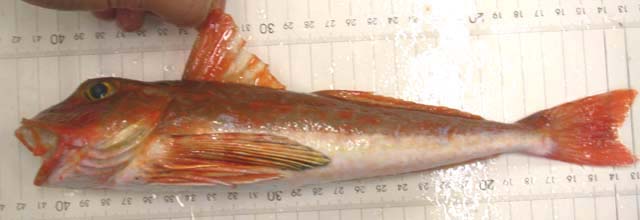| Triglidae (Searobins), subfamily: Triglinae |
| 60 cm TL (male/unsexed); max.weight: 1,500.0 g; max. reported age: 15 years |
|
demersal; brackish; marine; depth range 1 - 200 m |
| Indo-West Pacific: Delagoa Bay, Mozambique to the Cape, South Africa; common in Australia and New Zealand and reported from Japan and Korea. Also reported from Hong Kong (Ref. 12086). |
|
Dorsal spines (total): 9-10; Dorsal soft rays (total): 15-16; Anal spines: 0-0; Anal soft rays: 14-16; Vertebrae: 33-35. Olive or brownish in color, becomes red when stressed; lower half of the inner part of pectoral fin with large black blotch surrounded by numerous pale spots (Ref. 9771). |
| Found from estuaries to edge of continental shelves over sand and sandy shell seabed (Ref. 9258). Reported to be often found in rivers (Ref. 4316). Juveniles may occur in bays (Ref. 33616). Benthic (Ref. 58302). Dorsal spine reported to be venomous (Ref. 9771). Neither anterolateral glandular grooves nor venom gland is present (Ref. 57406). Current information in the table (dangerous fish) do not match; needs verification. Excellent food fish (Ref. 9771). Utilized fresh and frozen; eaten pan-fried, broiled, microwaved and baked (Ref. 9988). |
|
Least Concern (LC); Date assessed: 04 February 2009 Ref. (130435)
|
| venomous |
Source and more info: www.fishbase.org. For personal, classroom, and other internal use only. Not for publication.
